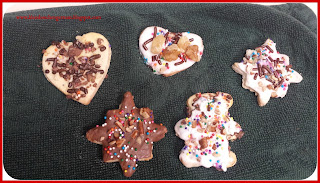Leckerbissen is a German word meaning treat, tidbit, or delicacy.
Lecker means yummy or delicious; ein Bissen is a bite.
These yummy bites are perfect for the holidays!
~*~*~*~*~*~
Baking is a part of many families' Christmas tradition, and Germans are no exception. There are several standard cookies that are just expected at Christmas time! For example,
Vanillekipferl ... or this recipe for a simple glazed Christmas Cookie.
My mother uses a basic, kneaded dough recipe that can be adapted for several varieties of cookies. This isn't like a sugar cookie dough either; it is less sweet.
DISCLAIMER: I am NOT a food photographer - and my mom isn't a professional cookie decorator. But these are THE REAL DEAL. Cookies decorated with a chocolate glaze, a powder sugar glaze, and a variety of nuts and sprinkles.
You can get as fancy or as simple as you please.
BASIC COOKIE DOUGH
source: my mom
500 g Mehl (4 cups flour)
2 tsp baking powder
2 Eier (eggs)
200 g Zucker (approx. 1 ½ cups sugar,
more to taste)
1 Pkg vanilla sugar (approx. 2
tsp)
Just a little lemon peel, finely zested
3 Mandeln (almonds), finely ground or chopped (optional)
250 g Butter or Margarine (1 ¾
sticks), cold and cut into small pieces
Egg yolk (to baste)
PREHEAT:
375 degrees F
Pour flour and baking powder on large surface, make a well in the middle.
Add sugar, vanilla sugar, lemon peel, and almonds. Add egg and work into half the dough. Top with butter/margarine pieces and knead all the dough until smooth. Let dough rest (in refridgerator, if possible) for about 30 minutes. Then roll out, cut out cookies with cookie cutters. Place on greased cookie sheet and brush with egg yolk. Bake in preheated oven for 8 to 12 minutes until golden. Let cool, then glaze (see below for recipe).
**Cinnamon or a little cocoa powder can be added to dough, if you prefer.
**Press various nuts into cookies before baking, if you like.
A smaller, simpler portion of dough from Dr. Oetker's recipe:
Knetteig / Kneaded Dough:
| 150 g | Weizenmehl (1 cup flour) |
| 1 Msp*. | Backpulver (about 1 tsp baking powder) |
| 50 g | Zucker (1/4 cup sugar) |
| 100 g | weiche Butter oder Margarine (7 tbsp softened butter or margarine) |
Mix as above and then bake at 350 degrees for 10-12 minutes
*Msp is short for "Messerspitze" which means knife tip.
GLAZE:
250 g Puderzucker (1 1/4 c. powder sugar)
2 egg's whites or 1 to 4 tbsp water or MILK (we use milk)
Mix to medium consistency (not too watery!) and brush glaze on cookies. Sprinkle with nuts or other decoration. Let "dry".
For Chocolate glaze:
1 1/4 c. powder sugar
3-4 tbsp milk
mix together in a small pan. Add 1-2 tbsp cocoa powder. Stir until dissolved. Brush on cookies right away!
OR Melt chocolate chips or baking chocolate or almond bark over a boiling water (double boiling). Brush on cookies immediately and decorate.
Get your vanilla sugar at
AMAZON:




















































